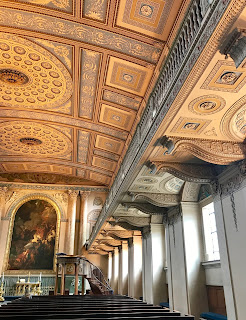 |
| Grass trodden by Thor! |
I promised myself never to take the sight of
Christopher Wren's distinctive Old Royal Naval College for granted, no matter how often I see it in my time at Greenwich.
It's an easy promise to keep. Every time
it comes into view, from river bus, footpath or big red bus, I marvel anew at
its symmetry of design, its grandeur and the centuries of cultural change it
communicates.
And I'm repeatedly awestruck that these elegant buildings were
completed and opened some 76 years before Lieutenant Cook landed at Botany Bay.
We white Australians have such a short
story.
 |
| Inside the Painted Hall |
Some of the internal spaces are equally stunning. Thornhill’s
Painted Hall is an exquisite storybook of characters from history and myth, and
the chapel never fails to make me think of fine Wedgewood china.
But, let's face it, it's also pretty gosh-darn impossible not to
be gobsmacked that, almost daily, I'm standing where the mighty Thor battled
Malekith, evil leader of the Dark Elves —— right there between the domes in beautiful
downtown Greenwich. Truly. Awesome.
 |
| Inside the chapel |
But these impressive buildings were created not just to inspire
awe and celebrate the glories of Britain. As the Royal Hospital for Seamen, they
housed thousands of pensioned seafarers,
plus the widows and children of such men. Some of the inhabitants were highly distinguished,
some were scoundrels. Many were quite unremarkable.
But life is a narrative.
Everyone, no matter how seemingly ordinary, has a story.
The Pensioners
And so it was that a small
group of enthusiastic amateur-historian volunteers became the Lives of Pensioners
Research Project. Our objective:
to transcribe some 250 wills of people who lived at the Hospital in the
18th and 19th centuries and,
using them as a starting point, to flesh out their narratives — to put the people
back in the buildings.
Just
reading the handwriting, dealing with variant spellings and navigating the lack
of punctuation in historical wills posed problems to we novices. So, a core
group of seven met over Tuesday morning coffee to compare notes, check each
other’s transcriptions and compile lists of names, places, words and dates that
needed further investigation.
I lack
the formidable knowledge of British history and naval traditions in general, and
of Greenwich in particular, that the others have. I didn't know the typical
names of the era and common place names were a mystery to me. I couldn't even
have told you what county Greenwich was in. Boatswain, testatrix, the Chalk Groins
— all strangers to me.
Bumpkin
from the Antipodes.
Pop kulcha
loving hick from the New World.
Definitely
odd-one-out.
That
is me.
 |
| Our summer picnic in the grounds with archive staff. |
Intelligent
AND witty AND willing to tolerate me.
Go
figure.
Proves
how great they are — right?
They
are the only people I've met in my three years in London who have included me
in anything.
I owe
them more than they can possibly imagine.
But I
digress.
Back
to the wills
 |
| ...and on this excursion day, we froze! |
We Pensioner
Researchers set out on a fun journey through genealogical data, naval records,
court and parish documents, rate books, letters, diaries, newspapers and
journals.
We
explored the treasures of the National Archives at Kew, Caird Library of the
National Maritime Museum, Wellcome Library, and Greenwich Heritage Centre. We
even visited cemeteries and Chatham Historic Dockyard. It's definitely been
what Pooh would call a grand adventure.
Many of the wills offer little to work with, but others give rise to fascinating questions or have quirky details to inform our investigations:
· pensioner Edmund Grenan stipulates that he be
buried at the very specific cost of £1 11s 6d. How much DID the average funeral
cost?
·
porter
John Woolley bequeaths
each person who supports his pall a hatband and gloves. Gloves seem reasonable,
but why a hatband?
·
Elizabeth Latham, a nurse 1707–1727, bequeaths
valuable fabric and silverware to her granddaughter, but leaves just one
shilling to her son, John. What did John do to piss her off?
We have been stirring up ghosts and helping them tell their
stories.
It's fun.
I'm pretty sure Stan Lee would approve.


